Johannes Vermeer
| Jan Vermeer van Delft | |
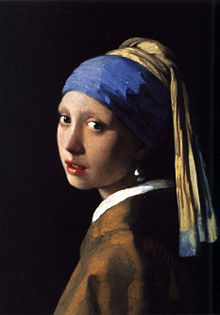 Girl with a Pearl Earring, known as the "Mona Lisa of the North" |
|
| Born | baptized October 31, 1632 Delft, Netherlands |
| Died | December 15, 1675 Delft, Netherlands |
| Nationality | Dutch |
| Field | Painting |
| Movement | Baroque |
| Works | About 35 paintings are known |
Johannes or Jan Vermeer (baptized in Delft with the name Joannis on October 31 1632, and buried in the same city under the name Jan on December 16 1675) was a Dutch Baroque painter who specialized in exquisite, domestic interior scenes of ordinary life. Vermeer was a moderately successful provincial genre painter in his lifetime. He seems never to have been particularly wealthy, perhaps because he produced relatively few paintings, leaving his wife and children in debt at his death.
Vermeer worked slowly and with great care, using bright colours, sometimes expensive pigments, with a preference for cornflower blue. He is particularly renowned for his masterly treatment and use of light in his work. What strikes in most of his paintings is a certain love, which easily could be called a love sickness, for the people and the objects in his paintings.[1] He created a world more perfect than any he had witnessed.[2]
After having been virtually forgotten for nearly one hundred years, Vermeer was rediscovered in 1866 when the art critic Thoré Bürger published an essay attributing 66 pictures to him (only 35 paintings are firmly attributed to him today). Since that time Vermeer's reputation has grown, and he is now acknowledged as one of the greatest painters of the Dutch Golden Age.
Contents |
Life
Relatively little is known about Vermeer's life. He seems to have been exclusively devoted to his art in the city of Delft. The only sources of information are some registers, a few official documents and comments by other artists; it was for this reason that Thoré Bürger named him "The Sphinx of Delft".[3] Vermeer became the subject of a biography by John Michael Montias: Vermeer and his milieu: a web of social history (Princeton, 1989), where the social history covers up for the elusiveness of the central character.
Youth

On October 31, 1632 Johannes was baptized in the Reformed Church.[4] His father, Reijnier Janszoon, was a middle-class silk or caffa worker.[5] As an apprentice in Amsterdam he had lived in the fancy Sint Antoniebreestraat, then a street with many painters. In 1615 he married Digna Baltus and in order to facilitate their marriage he brought a testimonial from Delft.[6] In 1620 a daughter Gertruy was baptized.[7] In 1625 Reynier Jansz was involved in a fight. The soldier died from his wounds five months later. A couple of years later Reynier Jansz had started to deal in paintings, but around 1631 he leased an inn called "The Flying Fox". Ten years later he bought a larger inn at the market square, named after the Belgian town "Mechelen". The acquisition of the inn constituted a considerable financial burden.[8] When Vermeer's father died in 1652, Vermeer replaced him as a merchant of paintings.
Marriage and family
Despite the fact that he was baptized in a Protestant church,[9] Johannes Reijniersz Vermeer married a Catholic girl named Catherina Bolenes. The blessing took place in a nearby and quiet village Schipluiden. For the groom it was a good match. His mother-in-law, Maria Thins, was significantly wealthier than he, and it was probably she who insisted Vermeer convert to Catholicism before the marriage on April 5, 1653.[10] Some scholars doubt Vermeer became Catholic, but one of his paintings, The Allegory of Catholic Faith, made between 1670 and 1672, reflects belief in the Eucharist. It was probably made expressly for a Catholic patron or for a schuilkerk, a hidden church.[11]
At some point the couple moved in with Catherina's mother, who lived in a rather spacious house at Oude Langendijk, close to a Jesuit church. Vermeer lived there for the rest of his life, producing paintings in the front room on the second floor. His wife gave birth to 14 children, of which ten survived: three sons and seven daughters. As the parish registers of the Delft Catholic church do not exist anymore, it is not 100% sure if they were baptized there. The names of ten children are known from wills, written by relatives: Maria, Elisabeth, Cornelia, Aleydis, Beatrix, Johannes, Gertruyd, Franciscus, Catharina, and Ignatius.[12] It is very likely that the youngest, Ignatius, was named after the founder of the Jesuit order. Four children were buried in Delft at an early stage (without a name) and their father was Johan Vermeer. When Catharina Bolnits was buried in 1688, she was registered as the widow of Johan Vermeer.
Career

It is not certain where Vermeer was apprenticed as a painter, nor with whom. It is generally believed that he studied in his home town and it is suggested that his teacher was either Carel Fabritius or more likely Leonaert Bramer.[13] It is possible he taught himself or had information from one of his father's connections.[14]
On December 29, 1653, Vermeer became a member of the Guild of Saint Luke, a trade association for painters. The guild's records make clear Vermeer did not pay the usual admission fee, a hint that his financial circumstances were difficult. In 1657 he might have found a patron in the local art collector Pieter van Ruijven, who lent him some money. In 1662 Vermeer was elected head of the guild and was reelected in 1663, 1670, and 1671, evidence that he was considered an established craftsman among his peers.
Vermeer worked slowly, probably producing three paintings a year, and on order. When Balthasar de Monconys visited him in 1663 to see some of his work, the diplomat and the two French clergymen who accompanied him were sent to a baker, probably Hendrick van Buyten, who owned one painting he was very proud of.
In 1672 a severe economic downturn (the "Year of Disaster") struck the Netherlands. Not only did a French army under Louis XIV invade the Dutch Republic from the south (known as the Franco-Dutch War), but an English fleet, in the Third Anglo-Dutch War and two allied German bishops attacked the country from the east, trying to destroy its hegemony. Many people panicked, and shops and schools were closed. Some years passed before circumstances improved. The collapse of the art market damaged Vermeer's business as both a painter and an art dealer, as his wife stated later. With a large family to support, Vermeer again was forced to borrow money.
In December 1675 Vermeer fell into a frenzy and died at the age of 43, within a day and a half. In a written document Catharina Bolnes attributed her husband's death to the stress of financial pressures. She, having to raise 11 children, asked the High Court to allow her a break in paying the creditors.[15]
The Dutch microscopist Antonie van Leeuwenhoek, who sometimes worked for the city council, was appointed trustee. The house, with eight rooms on the first floor, was filled with paintings, drawings, clothes, chairs and beds. In his atelier there were among rummage not worthy being itimized, two chairs, two painter's easels, three palettes, ten canvases, a desk, an oak pull table and a small wooden cupboard with drawers.[16] Nineteen of Vermeer's paintings were bequeathed to Catherina and her mother. The widow sold two more paintings to the baker in order to pay off the debts.
In Delft, Vermeer had been a respected artist, but he was almost unknown outside his home town, and the fact that a local patron, van Ruijven, purchased much of his output reduced the possibility of his fame spreading. Van Ruijven's son-in-law Jacob Dissius owned 21 paintings by Vermeer, listed in his heritage in 1695, which were sold the year after in Amsterdam. Vermeer never had any pupils and his relatively short life, the demands of separate careers, and his extraordinary precision as a painter all help to explain his limited output.
Technique
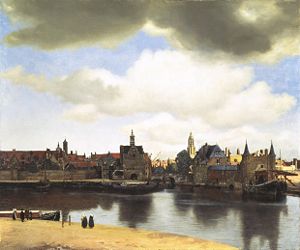
Vermeer produced transparent colours by applying paint to the canvas in loosely granular layers, a technique called pointillé (not to be confused with pointillism). No drawings have been positively attributed to Vermeer, and his paintings offer few clues to preparatory methods. David Hockney, among other historians and advocates of the Hockney-Falco thesis, has speculated that Vermeer used a camera obscura to achieve precise positioning in his compositions, and this view seems to be supported by certain light and perspective effects which would result from the use of such lenses and not the naked eye alone. The extent of Vermeer's dependence upon the camera obscura is disputed by historians.
There is no other seventeenth century artist who early in his career employed, in the most lavish way, the exorbitantly expensive pigment lapis lazuli, or natural ultramarine. Vermeer not only used this in elements that are naturally of this colour; the earth colours umber and ochre should be understood as warm light within a painting's strongly-lit interior, which reflects its multiple colours onto the wall.
This working method most probably was inspired by Vermeer’s understanding of Leonardo’s observations that the surface of every object partakes of the colour of the adjacent object.[17] This means that no object is ever seen entirely in its natural colour.
A comparable but even more remarkable yet effectual use of natural ultramarine is in The Girl with a Wineglass (Braunschweig). The shadows of the red satin dress are underpainted in natural ultramarine, and due to this underlying blue paint layer, the red lake and vermilion mixture applied over it acquires a slightly purple, cool and crisp appearance that is most powerful.
Even after Vermeer’s supposed financial breakdown following the so-called rampjaar (year of disaster) in 1672, he continued to employ natural ultramarine generously, such as in "Lady Seated at a Virginal." This could suggest that Vermeer was supplied with materials by a collector, and would coincide with John Michael Montias’ theory of Pieter Claesz van Ruijven being Vermeer’s patron.
Themes

Vermeer painted mostly domestic interior scenes. His works are largely genre pieces and portraits, with the exception of two cityscapes.
His subjects offer a cross-section of seventeenth century Dutch society, ranging from the portrayal of a simple milkmaid at work, to the luxury and splendour of rich notables and merchantmen in their roomy houses. Religious and scientific connotations can be found in his works.
Influence of other painters
- Carel Fabritius (1622–1654) who spent his final years in Delft. Vermeer's ideas about perspective, and his tendency to paint everyday themes were possibly influenced by Fabritius.
- Italian painter Caravaggio (1573–1610), indirectly through Dutch followers.
- Leonaert Bramer, another painter from Delft, and witness to his marriage.
- Vermeer's mother-in-law, Maria Thins, owned Dirck van Baburen's Procuress (or a copy of it), which appears in the background of two of Vermeer's paintings. The same subject was also painted by Vermeer in one of the artist's early works.
Works

Only three paintings are dated: The Procuress (1656, Dresden, Gemäldegalerie), The Astronomer (1668, Paris, Louvre), and The Geographer (1669, Frankfurt, Städelsches Kunstinstitut). Two pictures are generally accepted as earlier than The Procuress; both are history paintings, painted in a warm palette and in a relatively large format for Vermeer — Christ in the House of Mary and Martha (Edinburgh, National Gallery) and Diana and her Companions (The Hague, Mauritshuis).
After The Procuress almost all of Vermeer's paintings are of contemporary subjects in a smaller format, with a cooler palette dominated by blues, yellows and greys. It is to this period that practically all of his surviving works belong. They are usually domestic interiors with one or two figures lit by a window on the left. They are characterized by a serene sense of compositional balance and spatial order, unified by a pearly light. Mundane domestic or recreational activities become thereby imbued with a poetic timelessness (e.g. Woman Reading a Letter at an Open Window, Dresden, Gemäldegalerie). To this period also have been allocated Vermeer's two townscapes, View of Delft (The Hague, Mauritshuis) and A Street in Delft (Amsterdam, Rijksmuseum).
A few of his paintings show a certain hardening of manner and these are generally thought to represent his late works. From this period come The Allegory of Faith (c 1670, New York, Metropolitan Museum) and The Letter (c 1670, Amsterdam, Rijksmuseum).
The often-discussed sparkling pearly highlights in Vermeer's paintings have been linked to his possible use of a camera obscura, the primitive lens of which would produce halation and, even more noticeably, exaggerated perspective. Such effects can be seen in Lady at the Virginals with a Gentleman (London, Royal Collection). Vermeer's interest in optics is also attested in this work by the accurately observed mirror reflection above the lady at the virginals.
Today, 35 paintings are clearly attributed to Vermeer, although in 1866, Thoré Burger attributed a list of 66 pictures to him. The known paintings are:
| Image | Title | Year | Size | Place |
|---|---|---|---|---|
 |
Christ in the House of Martha and Mary | 1654-1655 | Oil on canvas, 160 x 142 cm | National Gallery of Scotland, Edinburgh |
 |
Diana and Her Companions | 1655-1656 | Oil on canvas, 98,5 x 105 cm | Mauritshuis, The Hague |
 |
The Procuress | 1656 | Oil on canvas, 143 x 130 cm | Gemäldegalerie Alte Meister, Dresden |
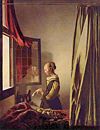 |
Girl reading a Letter at an Open Window | 1657 | Oil on canvas, 83 x 64,5 cm | Gemäldegalerie Alte Meister, Dresden |
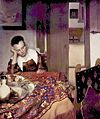 |
A Girl Asleep | 1657 | Metropolitan Museum of Art, New York | |
 |
The Little Street | 1657/58 | Rijksmuseum, Amsterdam | |
 |
Officer with a Laughing Girl | c. 1657 | Oil on canvas, 50,5 x 46 cm | Frick Collection, New York |
 |
The Milkmaid | c. 1658 | Oil on canvas, 45,5 x 41 cm | Rijksmuseum, Amsterdam |
 |
The Wine Glass, A Lady Drinking and a Gentleman | 1658-1660 | Oil on canvas, 39,4 x 44,5 cm | Gemäldegalerie, Berlin |
 |
The Girl with the Wineglass | c. 1659 | Oil on canvas | Herzog Anton-Ulrich-Museum, Braunschweig |
 |
View of Delft | 1659-1660 | Oil on canvas, 98,5 x 117,5 cm | Mauritshuis, The Hague |
 |
Girl Interrupted at her Music | 1660-1661 | Oil on canvas, 39,4 x 44,5 cm | Frick Collection, New York |
 |
Woman in Blue Reading a Letter | 1663-1664 | Oil on canvas, 46,6 x 39,1 cm | Rijksmuseum, Amsterdam |
 |
The Music Lesson or A Lady at the Virginals with a Gentleman | 1662/5 | Oil on canvas, 73,3 x 64,5 cm | Queen's Gallery, London |
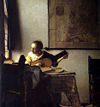 |
Woman with a Lute near a Window | c. 1663 | Oil on canvas, 51,4 x 45,7 cm | Metropolitan Museum of Art, New York |
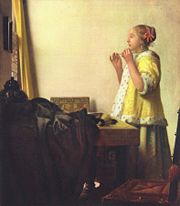 |
Woman with a Pearl Necklace | 1662-1664 | Oil on canvas, 55 x 45 cm | Gemäldegalerie, Berlin |
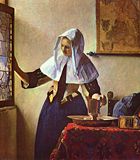 |
Woman with a Water Jug | 1660-1662 | Oil on canvas, 45,7 x 40,6 cm | Metropolitan Museum of Art, New York |
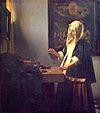 |
A Woman Holding a Balance | 1662-1663 | Oil on canvas, 42,5 x 38 cm | National Gallery of Art, Washington |
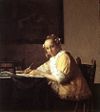 |
A Lady Writing a Letter | 1665-1666 | Oil on canvas, 45 x 40 cm | National Gallery of Art, Washington |
 |
Girl with a Pearl Earring (a.k.a. Girl In A Turban, Head Of Girl In A Turban, The Young Girl With Turban) | c. 1665 | Oil on canvas, 46,5 x 40 cm | Mauritshuis, The Hague (1 |
| The Concert | 1665-1666 | Oil on canvas, 69 x 63 cm | stolen in March 1990 from the Isabella Stewart Gardner Museum, Boston[18] | |
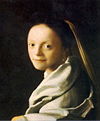 |
Portrait of a Young Woman | 1666-1667 | Oil on canvas, 44,5 x 40 cm | Metropolitan Museum of Art, New York |
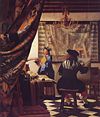 |
The Allegory of Painting or The Art of Painting | 1666/67 | Kunsthistorisches Museum, Vienna | |
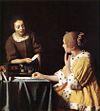 |
Mistress and Maid, Lady with her Maidservant Holding a Letter | 1667/68 | Frick Collection, New York | |
| Girl with a Red Hat | 1668 | National Gallery of Art, Washington | ||
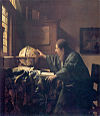 |
The Astronomer | 1668 | Louvre, Paris | |
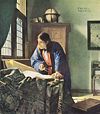 |
The Geographer | 1668/69 | Städelsches Kunstinstitut, Frankfurt am Main | |
 |
The Lacemaker | 1669/70 | Louvre, Paris | |
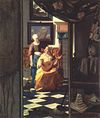 |
The Love Letter | 1669/70 | Rijksmuseum, Amsterdam | |
 |
Lady writing a Letter with her Maid | 1670 | Oil on canvas, 71,1 x 58,4 cm | National Gallery of Ireland, Dublin |
 |
The Allegory of Faith | 1671/74 | Metropolitan Museum of Art, New York | |
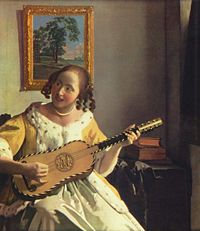 |
The Guitar Player | 1672 | Iveagh Bequest Kenwood House, London | |
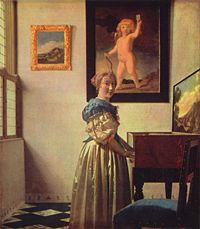 |
Lady Standing at a Virginal | 1673/75 | National Gallery, London | |
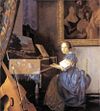 |
Lady Seated at a Virginal | 1673/75 | National Gallery, London |
Disputed works
- Saint Praxidis (c. 1655) - Oil on canvas, 102 x 83 cm, Private Collection
- Girl with a Flute (1665-1670) - Oil on panel, 20 x 17,8 cm, National Gallery of Art, Washington
- A Young Woman Seated at the Virginals (1670) - Wynn Las Vegas, Las Vegas
- Portrait of a Woman (1655-1660) -
- Girl with a Red Hat (1668) - Oil on panel, National Gallery of Art, Washington
Forgeries
Han van Meegeren was a Dutch painter who worked in the classic tradition. Initially seeking to prove that critics had underestimated his abilities as a painter, he decided to paint a fake Vermeer. Later, he forged more Vermeers and works of other painters to make money. Van Meegeren fooled the art establishment, and was only taken seriously after demonstrating his skills in front of police witnesses. His aptitude at forgery shocked the art world and complicated efforts to assess the authenticity of works attributed to Vermeer. After Van Meegeren's exposure in 1945 a wave of self-criticism surged through the world of art-museums and many so-called Old Masters disappeared from their walls. Examples are given in the Van Meegeren biography A New Vermeer, see references below.
Vermeer in other works
- Vermeer's View of Delft features in a pivotal sequence of Marcel Proust's The Captive.
- The book Girl with a Pearl Earring and the film of the same name are named after the painting; they present a fictional account of its creation by Vermeer and his relationship with the model.
- The book Girl in Hyacinth Blue is about a fictional Vermeer painting of the same name, and the 2003 made-for-TV film Brush with Fate is based on the book.
- The liqueur Vermeer Dutch Chocolate Cream Liqueur was inspired by and named after Vermeer and its bottle is embossed with his signature and has a logo incorporating the Girl with a Pearl Earring.
- Salvador Dalí, with great admiration for Vermeer, painted his own version of The Lacemaker and pitted large copies of the original against a rhinoceros in some now-famous surrealist experiments. Dali also immortalized the Dutch Master in The Ghost of Vermeer of Delft Which Can Be Used As a Table, 1934.
- The 2003 children's novel Chasing Vermeer by Blue Balliett describes the theft of A Lady Writing and has the authenticity of Vermeer's paintings as a central theme. Also, in the sequel to the book, The Wright 3.
- Dutch composer Louis Andriessen based his opera, Writing to Vermeer (1997-98, libretto by Peter Greenaway), on the domestic life of Vermeer.
- Greenaway's own film A Zed & Two Noughts (1985) contains a plot line about an orthopedic surgeon named Van Meegeren who stages highly exact scenes from Vermeer paintings in order to paint copies of them.
- "Brush with Fate" was a made-for-TV film debuted on February 2, 2003, on CBS. It followed the life of an imaginary painting by Dutch painter Johannes Vermeer as it passes through the hands of various people.
- The book and film Girl, Interrupted take their title from the painting Girl Interrupted at her Music.
- Jan Vermeer is the title of a song on Bob Walkenhorst's solo album, The Beginner (lyrics here, song #6). Walkenhorst is the guitarist and principal songwriter for The Rainmakers.
- No One Was Like Vermeer is the title of a song on Jonathan Richman's 2008 album Because Her Beauty Is Raw And Wild.
- All the Vermeers in New York, a film by Jon Jost

References and notes
- ↑ Oosthoek's Geïllustreerde Encyclopaedie (1917).
- ↑ W. Liedtke (2007) Dutch Paintings in the Metropolitan Museum of Art, p. 867.
- ↑ Vermeer: A View of Delft The Economist. Retrieved January 9, 2008.
- ↑ Look in http://www.archief.delft.nl/. There the painter is recorded as: Child = Joannis; Father = Reijnier Jansz; Mother = Dingnum Balthasars; Witnesses = Pieter Brammer, Jan Heijndricxsz, Maertge Jans; Place = Delft; Date of baptism = 31-10-1632.
- ↑ His name was Reijnier or Reynier Janszoon, (in Dutch always written as Jansz. or Jansz), his patronym. As there was another Reijnier Jansz. at that time in Delft, he preferred to use the last name Vos (= Fox) as an alias, but from 1640 on he had changed his alias in Vermeer.
- ↑ http://www.xs4all.nl/~kalden/dart/d-a-vermeer1.htm
- ↑ In 1647 Vermeer's only sister married a frame maker, but kept on working at the inn helping her parents, serving drinks and making beds.
- ↑ Giants of Delft By Robert D. Huerta, p. 42-43. [1]
- ↑ http://www.essentialvermeer.com/vermeers_name.html
- ↑ Catholicism was not a forbidden religion, but tolerated in the Dutch Republic, due to the Dutch Revolt. Services were held in secret and Catholics were restrained in their careers, unable to get high ranking jobs in cities' administration or the national government. After 1648 some seemed to have tired of the religious differences and returned to the Catholic church.
- ↑ W. Liedtke (2007) Dutch Paintings in the Metropolitan Museum of Art, p. 893.
- ↑ J.M. Montias, p. 370-371.
- ↑ Vermeer biography, National Gallery of Art Retrieved July 13, 2007.
- ↑ W. Liedtke, p. 866.
- ↑ J.M. Montias, p. 344-345.
- ↑ J.M. Montias, p. 339-344.
- ↑ B. Broos, A. Blankert, J. Wadum, A.K. Wheelock Jr. (1995) Johannes Vermeer, Waanders Publishers, Zwolle
- ↑ Stolen, a documentary about the theft of The Concert, from the PBS website
Sources
- Sheldon, Libby; Nicola Costaros (February 2006). "Johannes Vermeer’s ‘Young woman seated at a virginal". The Burlington Magazine CXLVIII (1235)..
- Schneider, Nobert (1993). Vermeer. Cologne..
- Wadum, J. (1998). "Contours of Vermeer". in I. Gaskel and M. Jonker. Vermeer Studies. Studies in the History of Art. Washington/New Haven: Center for Advanced Study in the Visual Arts, Symposium Papers XXXIII. pp. 201–223..
- Vermeer, Johannes. (2007). In Encyclopædia Britannica. Retrieved July 13, 2007, from Encyclopædia Britannica Online: [2].
- Kreuger, Frederik H. (2007). New Vermeer, Life and Work of Han van Meegeren. pp. 54, 218 and 220 give examples of Van Meegeren fakes (or possible Van Meegeren fakes) that were removed from their museum walls. Pages 220/221 give an example of a non-Van Meegeren fake attributed to him. ISBN 978-90-5959-047-2.[3]
- Wheelock, Arthur K., Jr. (1981,1988). Jan Vermeer. ISBN 0-8109-1737-8. Contains history and color plates, or photographs, of nearly/all works along with commentary and history of them. Also includes background information on Vermeer and his time.
External links
- Vermeercentrum, housed at the site of the former St. Lucas Guild in Delft. (This reference states that the Vermeercentrum has been closed, in the mean time it has been reopened again: December 2007).
- Essential Vermeer, in-depth coverage of Vermeer's life and works.
- Virtual Vermeer, Biography, Paintings.
- http://www.richeast.org/htwm/VERMEER/VERMEER.HTML
- Vermeer's Woman Holding a BalanceIn-depth discussion of this painting in the National Gallery of Art along with discussion of the artist's life, conservation, illustration of related works.